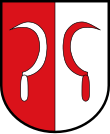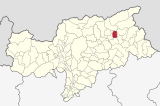Pfalzen
| Pfalzen | |
|---|---|
| (Italian: folds ) | |
| coat of arms | map |
| State : | Italy |
| Region : | Trentino-South Tyrol |
| Province : | Bolzano - South Tyrol |
| District community : | Val Pusteria |
|
Inhabitants : (VZ 2011 / 31.12.2019) |
2,670 / 2,860 |
|
Language groups : (according to 2011 census ) |
96.25% German 2.36% Italian 1.39% Ladin |
| Coordinates | 46 ° 49 ′ N , 11 ° 53 ′ E |
| Altitude : | 880– 2450 m slm (center: 1220 m slm ) |
| Surface: | 33.24 km² |
| Permanent settlement area: | km² |
| Parliamentary groups : | Greinwalden , Issing |
| Neighboring municipalities: | Gais , Kiens , Bruneck , St. Lorenzen , Mühlwald |
| Postal code : | 39030 |
| Area code : | 0474 |
| ISTAT number: | 021030 |
| Tax number: | |
| Mayor (2015): | Josef Gatterer ( SVP ) |
Pfalzen ( Italian Falzes ) is a municipality with 2860 inhabitants (as of December 31, 2019) in the Pustertal . Pfalzen is located about three kilometers northwest of Bruneck in the northeast of South Tyrol in Italy .
geography
Pfalzen is located in the South Tyrolean Pustertal , just west of the Brunico expanse , in which the nearby city of Bruneck extends and where the Tauferer Tal joins from the north. The municipal area with an area of 33.24 km² occupies a low mountain range terrace on the sunny side of the Pustertal valley, which runs in east-west direction, as well as the mountains rising behind it to the north.
The most significant rural center of the community is the main town palaces (1000- 1130 m slm ), beside which consist fractions Greinwalden (940- 970 m ) just east and Issing (970- 1,020 m ) just to the west, and several other scattered hamlets . The level of the terrain, which slopes down to the Puster Valley floor in the south, forms the municipal boundary to St. Lorenzen and Kiens , which also includes the Hofern faction, which adjoins the settlement terrace to the west .
North over the settlement areas, the terrain rises to the southeastern foothills of the Zillertal Alps , which separate Pfalzen from Mühlwald in the Mühlwald valley . The Sambock ( 2396 m ) and the Bärentalerspitze ( 2450 m ) are among the most important peaks in the municipality .
Population development
| Population development | ||||||||||||||||||||||||
|---|---|---|---|---|---|---|---|---|---|---|---|---|---|---|---|---|---|---|---|---|---|---|---|---|
Source: Istat |
history
The name Pfalzen
The name Pfalzen looks back on a long history. The name Pfalzen, then Phalanza, was first mentioned in 1050.
The current name was created by shifting sounds and changing vocabulary as well as combining words. The word root is to be regarded as Etruscan and could be associated with -pal . The word -pal in turn means something like rock or stone.
Falzes in the Middle Ages
It must be assumed that the development of the settlement in Pfalzen had already been completed by this time. This emerges from the first documents from the year 1100, in which the farm is recorded as a permanent farm structure with all affiliations. Thus, Pfalzen was capable of considerable output.
The place name Pfalzen is still used today by the very old South Tyrolean noble family Mörl von Pfalzen and Sichelburg, from which z. B. the mystic Maria von Mörl came from.
politics
- South Tyrolean People's Party : 14
- The Freedom : 1
Mayor since 1952:
- Johann Baumgartner: 1952–1956
- Johann Hainz: 1956–1969
- Luis Durnwalder : 1969–1973
- Johann Hainz: 1973–1974
- Hartmann Willeit: 1974–1990
- Manfred Hainz: 1990-2005
- Josef Gatterer: since 2005
education
There is a primary school in Pfalzen that is part of the German school district of the neighboring municipality of Bruneck II .
Attractions
On July 8, 2017, the Puppenmuseum in Anselm-Sparber-Str. 1 opened. It is the largest exhibition of its kind in all of South Tyrol.
Personalities
- Michael Pacher (around 1435–1498), late Gothic painter and sculptor.
- Oswald von Wolkenstein (around 1377–1445), singer, poet and composer, as well as a politician of more than just regional importance, was probably born at Schöneck Castle .
- Siegfried Mazagg (1902–1932), architect, draftsman and caricaturist.
- Luis Durnwalder (* 1941), former governor of South Tyrol.
- Karl Reichegger, multiple national and international master in hang gliding (-Delta).
- Roland Tinkhauser (* 1974), member of the state parliament, vice-party chairman and Pustertal district spokesman for the South Tyrolean Freedom Party.
literature
- Josef Niedermair, Josef Harrasser (Hrsg.): Pfalzen in words and pictures . Falzes 1987
- Christina Antenhofer: Field name book of the municipality of Pfalzen: A historical landscape in the mirror of their names . Wagner, Innsbruck 2001 (= Schlern writings 316)
- Stefan Lechner (Hrsg.): Falzes: Landscape - Culture - History. Weger, Brixen 2010, ISBN 978-88-88910-91-8 ( online )
Web links
- Official website of the municipality of Pfalzen
- Landscape plan of the municipality of Pfalzen . Office for Landscape Ecology, Autonomous Province of Bolzano - South Tyrol (PDF file)
- Entry in the Tirol Atlas of the Institute for Geography at the University of Innsbruck
Individual evidence
- ↑ The mayors of the South Tyrolean municipalities since 1952. (PDF; 15 MB) In: Festschrift 50 Years of the South Tyrolean Association of Municipalities 1954–2004. Association of South Tyrolean municipalities, pp. 139–159 , accessed on November 16, 2015 .
- ^ School district Bruneck II. South Tyrolean Citizens' Network , accessed on October 25, 2014 .




